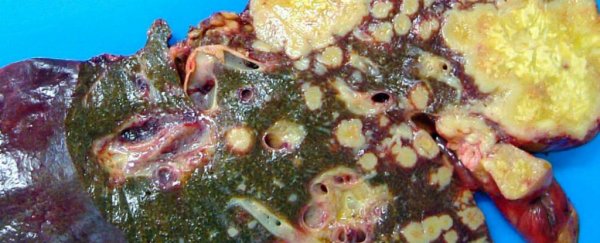A deadly parasitic liver worm could be useful in medicine, thanks to the fact that it secretes a substance that promotes wound healing and blood vessel growth, according to researchers from James Cook University (JCU) in Australia.
Tens of thousands of people are killed every year by bile duct cancer associated with the oriental liver fluke Opisthorchis viverrini, which people in Southeast Asia can contract from eating raw fish. However, as with a lot of parasites, the liver fluke doesn't want to kill its host quickly - in fact, a person can have the parasite wandering around their liver for decades before developing the incurable and lethal cholangiocarcinoma in the bile ducts. It is estimated that approximately 10 million people in Thailand and Laos are infected with this flatworm, which the WHO has classified as a group 1 carcinogen (yep, same group as bacon).
Albeit tiny, the liver fluke is in fact a complex organism, according to researchers. "They've got their own nervous system, they've got their own digestive system very much like ours, they've got a mouth, they digest blood, and they've got all sorts of similarities with higher eukaryotes and invertebrates," JCU's immunoparasitology expert Alex Loukas told Penny Timms at ABC.
As JCU scientists discovered a couple of years ago, the nasty worm actually secretes a growth factor which literally patches up the wounds created as it eats through a person's liver. "As it feeds on blood and tissue in the liver, the worm creates wounds, and then heals them, we suspect," said microbiologist Michael Smout, who led the discovery. "This is good for the host in the short term, but repeated wounding and healing over decades combined with chronic inflammation can lead to this deadly form of cancer."
In a recent study published in PLOS Pathogens, Smout and colleagues described their findings for the first time, taking a close look at the molecules of the growth factor secreted by the worm, Ov-GRN-1. By applying it to wounds in mice, they found it significantly sped up healing and even blood vessel growth, as opposed to controls.
The scientists are interested in this molecule for a couple reasons. Firstly, the growth factor could be developed into a highly potent treatment for the chronic wounds that just won't heal in some patients.
"There are increasing numbers of inflammatory diseases such as diabetes and associated non-healing wounds," Smout said in a press statement. "A powerful wound healing agent designed by millennia of host-parasite co-evolution may accelerate the impaired healing processes that plague diabetic and elderly patients."
But that's just one of the medical applications. Better understanding of how Ov-GRN-1 works in our cells could also help scientists develop a vaccine that could work against the cancer-causing properties of the liver fluke.
That's still a long way off, though - because researchers are still finding out more about the biological mechanisms of the growth factor, and inhibiting wound healing with a vaccine could have unintended consequences for the patient. However, the team believes parasite growth factors "offer great promise" as potential treatments.
James Cook University is a sponsor of ScienceAlert. Find out more about their research.
